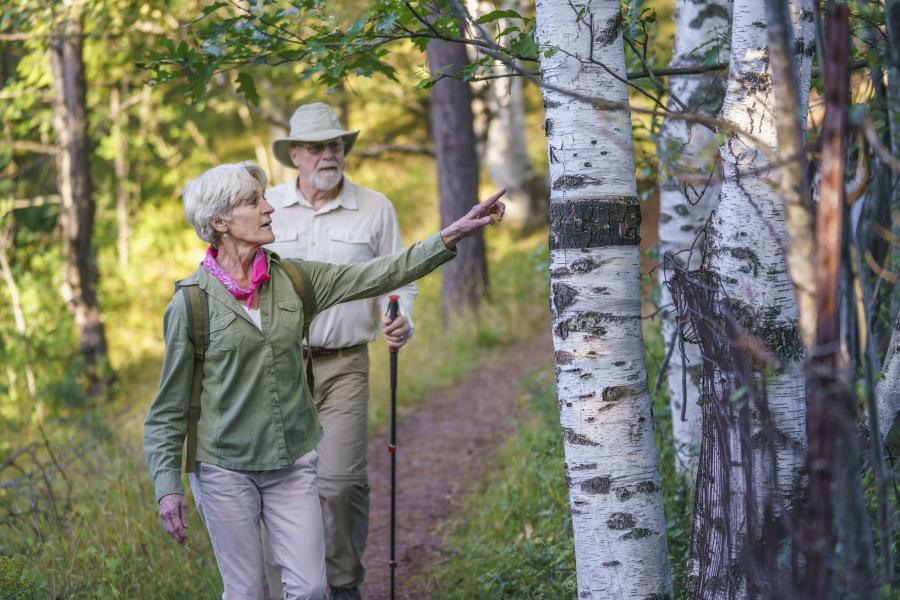Spring is a great time to get outdoors and enjoy the sights and sounds of nature. Spring is also a great time to go birding. The U.P. is home to more than 400 native bird species, with many more migrating through during spring and fall. The Marquette region’s diverse natural surroundings also happen to be excellent bird habitat.
May is peak spring migration for the region, according to BirdCast, which provides real-time predictions of bird migrations and a list of bird species you can expect to find, so it is the perfect time of year to explore birding in Marquette County.

Presque Isle Park
A great place to start your birding adventure is Presque Isle Park, said ornithologist Dr. Alec Lindsay, professor of Biology at Northern Michigan University in Marquette. The park’s 2.3-mile paved loop is a favorite among locals for its spectacular views of Lake Superior and offers abundant birding opportunities.
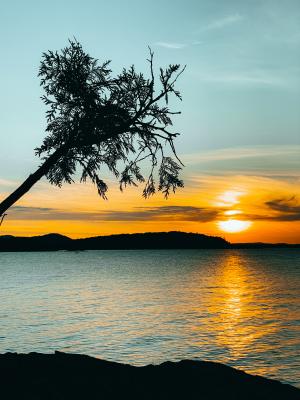
Sunset Point, at the tip of the peninsula, is a cool spot to watch migrating waterbirds and marsh birds soar over the lake, in addition to being the perfect place to take in a Superior Sunset.
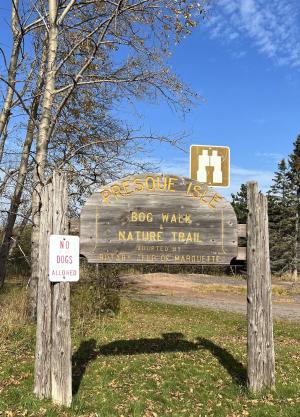
The Bog Walk is a short quarter-mile loop trail at the park’s entrance that features interpretive signs and a wooden boardwalk that wanders through the wetlands and offers excellent wildlife viewing.
You’ll see and hear migratory songbirds — sparrows, warblers, grackles, jays, and finches — along with other wildlife like turtles, and frogs, like the spring peeper, the tiny frog with the big voice. Peregrine falcons nest there and the wetlands have been known to attract some uncommon species, so you never know what birds you might spot.
The Moosewood Nature Center hosts events and talks. Check their calendar to see what’s happening, and stop in to see their exhibit of striking bird photos taken by local photographer Jennifer Cosco. The Laughing Whitefish Bird Alliance, an independent chapter of Michigan Audubon, also hosts bird outings and presentations, and welcomes birders of all experience levels, says the group’s president Jeff Towner.
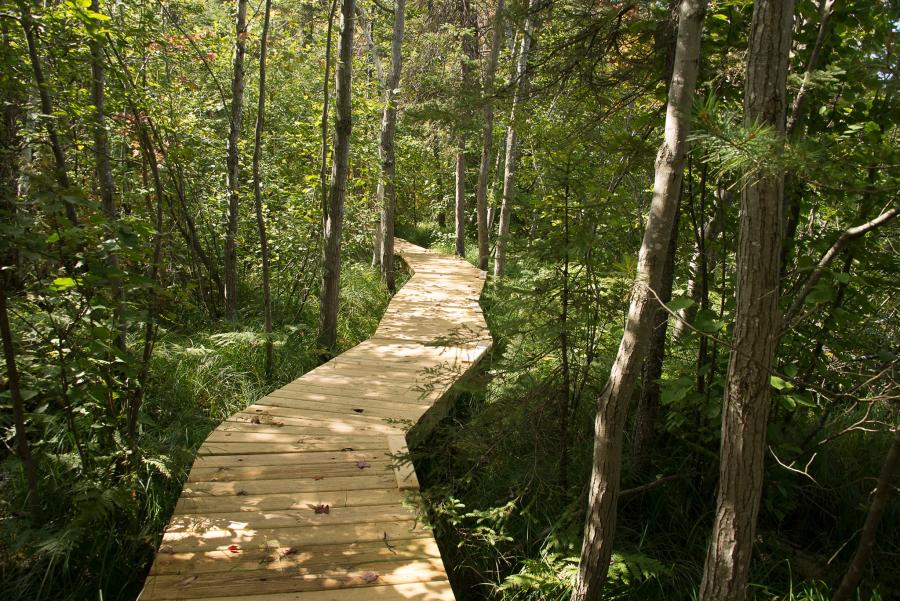
Chocolay Bayou Nature Preserve
Another great birding spot is the Chocolay Bayou Nature Preserve, situated at the mouth of the Chocolay River, in neighboring Harvey. These 13 acres of protected wetlands serve as an important stop on the bird migration highway.
The preserve has a birding trail with 11 interpretive signs featuring birds seen there, a boardwalk, benches, even a bird lookout, and is an idyllic spot for a bird walk or quiet little jaunt through nature.
There you will see waterfowl and wetlands warblers, like the Common Yellowthroat, a shy little bird that prefers to hide among the rushes, so you may hear them before you spot their bright yellow throats and black bandit masks of the males.
Dead River Marshes
The marshes along the Dead River also offer great birdwatching habitat, said Dr. Lindsay. Take Powder Mill Road out until it runs along the edge of the river. There is also a parking area near the mouth of the Dead River where you can sit and watch for marsh birds. Look for Great Blue Herons, Sandhill Cranes, Bufflehead Ducks, Redwing Blackbirds, Double Crested Cormorants, and more.
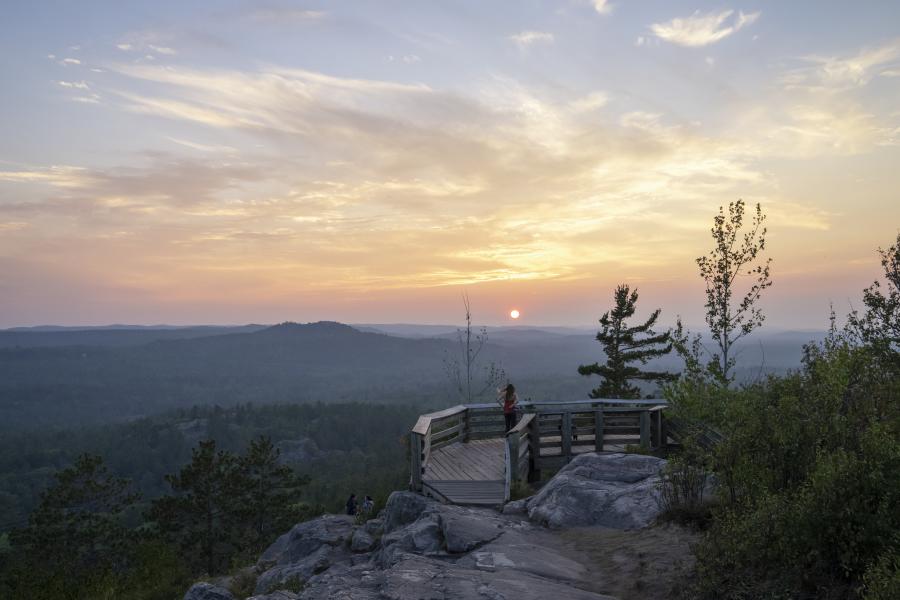
Sugarloaf Mountain
The top of Sugarloaf Mountain, with its three observation decks and panoramic views all around, offers a spectacular setting to watch for migrating raptors. Species spotted include Sharp-Shinned Hawks, Broad-winged Hawks, Red-tailed Hawks, Golden Eagles, Bald Eagles, American Kestrels, Peregrine Falcons, as well as ravens, crows, woodpeckers, gulls, and more. The gravel pit on County Road 550 also makes a great raptor-watching spot, said Dr. Lindsay.
Birding Benefits
Whether you are a novice or expert birder, one thing you’ll discover when you are out birding is you start to notice a lot more than birds, explained Dr. Lindsay.
“Things like a dead tree poking up in the middle of an isolated field that we might think should be cut down. Then you see four birds fighting over access to it because they are announcing themselves and trying to attract a mate.”
You start to understand more about your natural environment as you begin to see with the bird’s eye instead of with our human eyes.

Another benefit to birdwatching is it requires you to tune out of yourself and tune in to what's going on around you.
“Sometimes after an hour of birdwatching, you stop and think, I did not even think about my troubles,” said Dr. Lindsay. “The birds allow you to step out of yourself and get into a Zen feeling when you’re birdwatching.”
Jeff Towner, with the Laughing Whitefish Bird Alliance, agrees.
“The unexpected joys of birding can be many,” he said.
Getting outdoors early in the morning when birds are active and singing has both mental and physical benefits.
Birding can also be a great social activity, said Towner.
“It's a great way to find community,” said Dr. Lindsay. “If you're watching birds and you see other people out there with their binoculars, you have every right to go over and say, “Hey, what are you seeing? You make friends just because you are carrying binoculars and are interested in the same thing. It's like you're automatically cheering for the same home team — and you find them in the woods. There's a sense of community that birds bring to people.”

Birding Backpack
Before heading out for your birding adventure, it’s always wise to check the weather forecast. A clear, cold spring morning can give way to sunny skies in the afternoon or rain or snow showers, so plan accordingly. Include rain or snow gear in your pack, along with these birding essentials:
-
Binoculars
-
Birding field guide and checklist
-
Sunglasses and hat
-
Trail maps and compass
-
Water and snacks
-
Cell Phone with the Merlin app
-
Insect repellant
Before you go
Spring Trail Etiquette
Before adventuring, check out these Leave No Trace guidelines to be a more responsible steward of our outdoor spaces this spring. Read More
Code of Birding Ethics
While exploring be sure to follow the American Birding Association’s Code of Birding Ethics. Read More
Keep exploring
Marquette Spring Itinerary
Spring brings new opportunities to explore. From an invigorating stroll along the shore to... Read More
Hiker's Guide to Marquette
Discover hikes of all types in Marquette County—all ranging in difficulty, none lacking in... Read More
Hidden Gems of the West End
If you've never been to Negaunee or Ishpeming, MI, you're missing out on a slew of hidden... Read More
Marquette's Rich History: Mining, Timber, and Maritime Trades
RICH IN MINERALS The largest city in Michigan’s densely forested Upper Peninsula,... Read More

